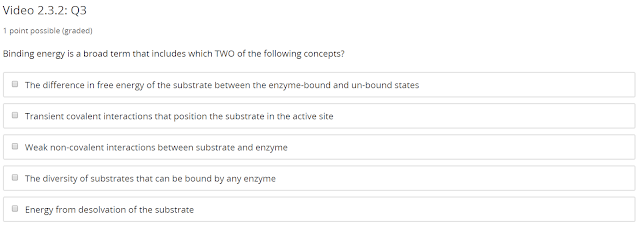Enzyme catalyze reactions by making
"Weak non-covalent interaction between enzyme and substrate" and
"Transient covalent bond between enzyme and substrate".
So those are the answers.
Permanent bond would be useless for catalyzing reaction.
Binding energy is the result of these interactions.
Re-solvation is not defined.
D is the binding energy - this is the reduction of free energy in the transient state.
B is the activation energy of the enzyme catalyzed reaction.
I failed this one, twice, I still do not understand, the answer is
Weak non-covalent interaction between substrate and enzyme, and
Energy from desolvation of the substrate.
What I don't understand is if "Weak non-covalent interaction between substrate and enzyme" is an answer, then why "Transient covalent interaction that position the substrate in the active site" not an answer?
Overall - I am just confused by my "type-checker" - an energy is energy, an interaction and an interaction, type mismatch! And interaction can lead to the reduction of energy, sure, but an interaction is not an energy!
Desolvation is the process of replacing environment - substrate bonds with substrate - enzyme bonds.





No comments:
Post a Comment